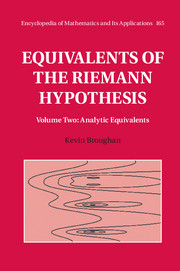Book contents
- Frontmatter
- Dedication
- Epigraph
- Contents
- Miscellaneous Frontmatter
- List of Illustrations
- List of Tables
- Preface for Volume Two
- List of Acknowledgements
- 1 Introduction
- 2 Series Equivalents
- 3 Banach and Hilbert Space Methods
- 4 The Riemann Xi Function
- 5 The De Bruijn–Newman Constant
- 6 Orthogonal Polynomials
- 7 Cyclotomic Polynomials
- 8 Integral Equations
- 9 Weil's Explicit Formula, Inequality and Conjectures
- 10 Discrete Measures
- 11 Hermitian Forms
- 12 Dirichlet L-Functions
- 13 Smooth Numbers
- 14 Epilogue
- Appendix A Convergence of Series
- Appendix B Complex Function Theory
- Appendix C The Riemann–Stieltjes Integral
- Appendix D The Lebesgue Integral on R
- Appendix E The Fourier Transform
- Appendix F The Laplace Transform
- Appendix G The Mellin Transform
- Appendix H The Gamma Function
- Appendix I The Riemann Zeta Function
- Appendix J Banach and Hilbert Spaces
- Appendix K Miscellaneous Background Results
- Appendix L GRHpack Mini-Manual
- References
- Index
1 - Introduction
Published online by Cambridge University Press: 27 October 2017
- Frontmatter
- Dedication
- Epigraph
- Contents
- Miscellaneous Frontmatter
- List of Illustrations
- List of Tables
- Preface for Volume Two
- List of Acknowledgements
- 1 Introduction
- 2 Series Equivalents
- 3 Banach and Hilbert Space Methods
- 4 The Riemann Xi Function
- 5 The De Bruijn–Newman Constant
- 6 Orthogonal Polynomials
- 7 Cyclotomic Polynomials
- 8 Integral Equations
- 9 Weil's Explicit Formula, Inequality and Conjectures
- 10 Discrete Measures
- 11 Hermitian Forms
- 12 Dirichlet L-Functions
- 13 Smooth Numbers
- 14 Epilogue
- Appendix A Convergence of Series
- Appendix B Complex Function Theory
- Appendix C The Riemann–Stieltjes Integral
- Appendix D The Lebesgue Integral on R
- Appendix E The Fourier Transform
- Appendix F The Laplace Transform
- Appendix G The Mellin Transform
- Appendix H The Gamma Function
- Appendix I The Riemann Zeta Function
- Appendix J Banach and Hilbert Spaces
- Appendix K Miscellaneous Background Results
- Appendix L GRHpack Mini-Manual
- References
- Index
Summary
Why This Study?
The Riemann hypothesis (RH) has been called the greatest unsolved problem in number theory, and even the greatest unsolved problem in mathematics. It has been around for over 150 years, and is “not expected to be solved any time soon”, according to the late Atle Selberg. It has given rise to a great industry of consequences, generalizations, unsuccessful proof attempts, mathematical theories and equivalent forms. It is a class of equivalent forms that is the subject of this volume, namely the classical analytic equivalents.
Leading mathematicians have written a great deal about and around the Riemann hypothesis and its variants and connections, and the interested reader is directed to this valuable, content-rich, set of sources, which includes: 2000–2001, the Clay Mathematics Institute Millennium Prize official problem description, “Problems of the millennium: the Riemann hypothesis” by Enrico Bombieri [34]; 2003, “The Riemann hypothesis” by J. Brian Conrey [57]; 2004, “Problems of the millennium: the Riemann hypothesis” by Peter Sarnak [214]; 2009, “What is the parity phenomenon?” by John Friedlander and Henryk Iwaniec [88]; 2010, “The classical theory of zeta and L-functions” by Enrico Bombieri [36]; and 2015, “An essay on the Riemann hypothesis” by Alain Connes [55]. Readers are also encouraged to consult the text “The Riemann hypothesis” by Barry Mazur and William Stein [167, parts II–IV].
These works describe the nature of the hypothesis, its importance and context, and many aspects of current ideas on how it and its relatives might be resolved. No attempt is being made to summarize this material here, but there are some brief comments in the Epilogue to this volume.
A range of arithmetic equivalents to the classical RH are set out in Volume One [39]. That work focuses on many of the classical equivalents to RH. Discussion of modern proposed equivalents, which have geometric and topological ingredients, broadly interpreted, are outside of the scope of this volume, and are in many cases still evolving or conjectural. They represent a great deal of current work.
An equivalence to RH is a very strong implication, so strong that it uses the full power of the hypothesis, and can only be true if the hypothesis is also true. If RH is proved to be true, then each of the equivalences and all of their derived implications of course are true also.
- Type
- Chapter
- Information
- Equivalents of the Riemann Hypothesis , pp. 1 - 7Publisher: Cambridge University PressPrint publication year: 2017

